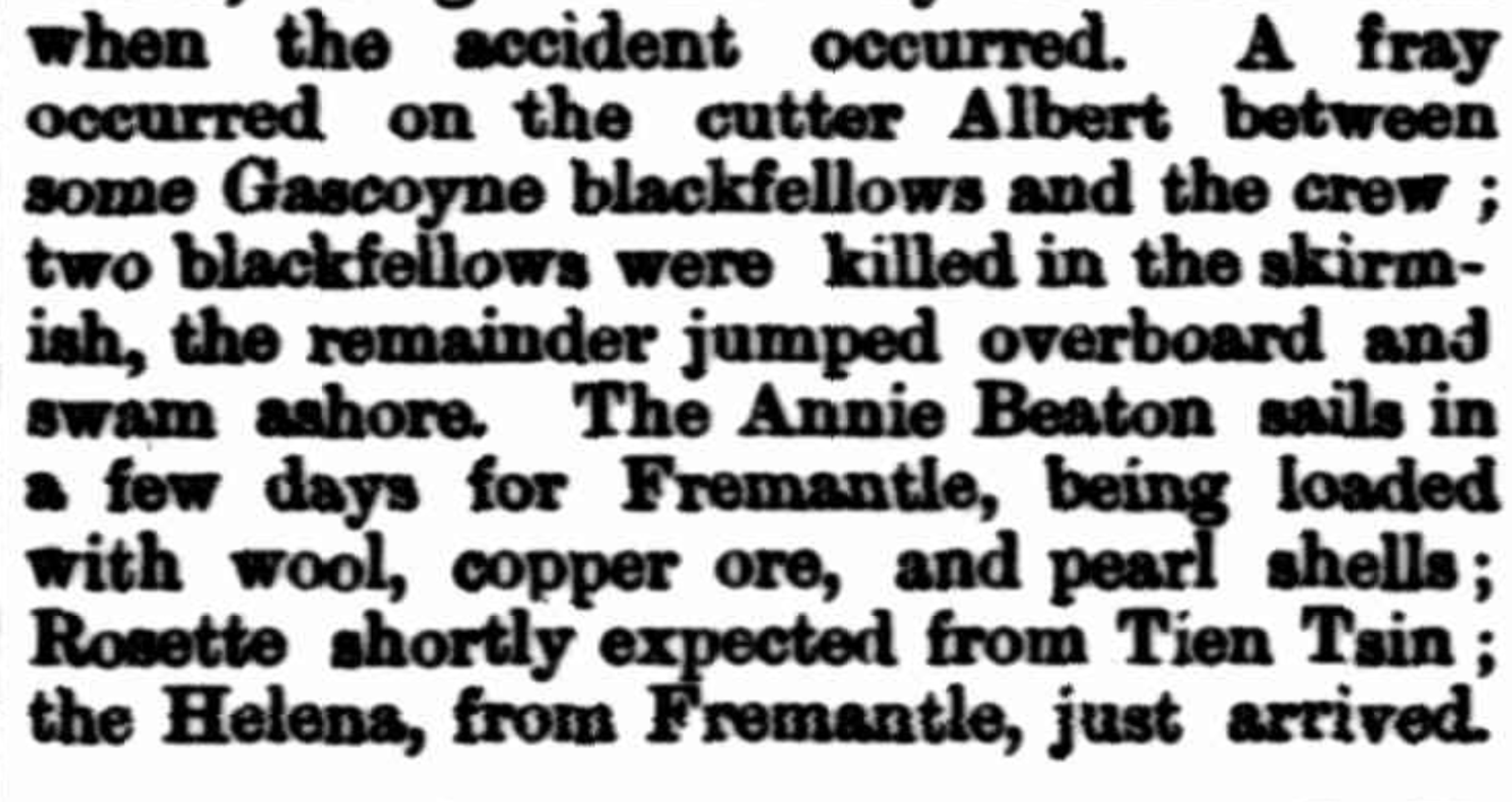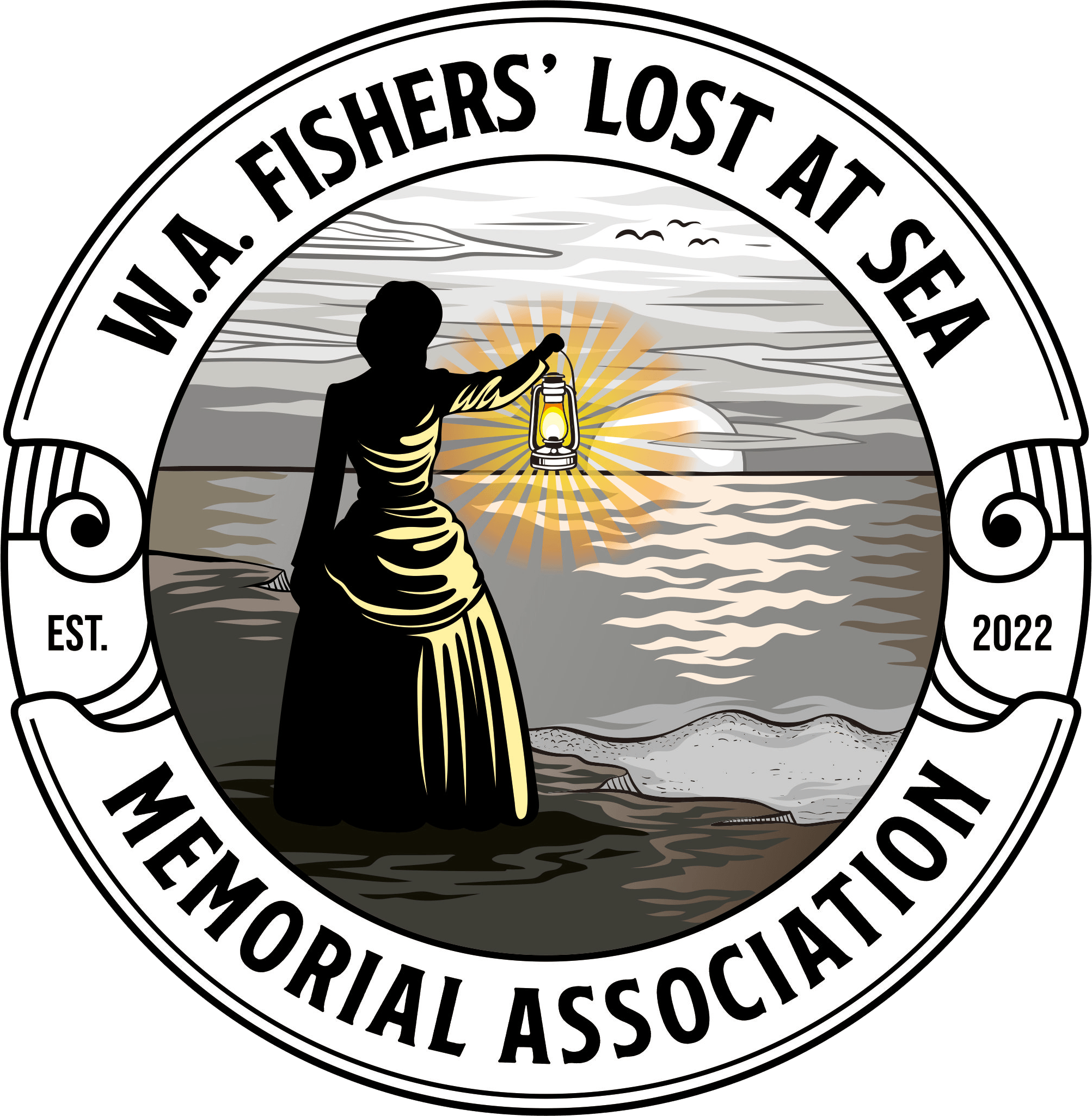Albert
Vessel Name: Albert
Nirba
Ballemerda
Died from wounds received in onboard incident
27 October 1875

The Inquirer and Commercial News, Wednesday 22 December 1875
The Albert was a 28 ton cutter, built in 1861 in a Swan River boatyard for Richard Harford “boatman” and Charles Howlett, “warehouseman”. She was carvel-built, with a square stern, measuring 45.2 x 14.4 x 5.7 feet (13.6 x 4.4 x 1.7 metres). She was launched on 10 July 1862, and registered as No. 1 of 1862. Her official number was 36544. Being duly registered, she was launched as a local trading vessel. This was the start of a long and eventful career across various industries and many waters. Albert was inadvertently involved in the deaths of four people, during two of her darkest incidents.
We next hear of Albert in Champion Bay (Geraldton) in 1867. She had left Fremantle, and arrived in Geraldton on 1 August, where she was ordered by government to search for two vessels recently wrecked at the Abrolhos Islands, the Brothers and Emily. Albert put out for the Abrolhos Islands on 8 August in heavy squalls. She struck reef on the 11 August, one kilometre from Goss Monument (Beacon Island). Her crew unloaded ballast and attempted to refloat her. By 19 August the crew rigged a mast and sail to their dinghy and three crew members made sail for Geraldton. The Swan was dispatched to help refloat Albert. The cutter Victoria passing the area also assisted. Albert had been sitting on a bed of soft coral and was not damaged. Finally, the refloated Albert left Champion Bay bound for Roebourne, chartered to carry 225 kilograms of gunpowder.
On 15 February 1868 Albert was commandeered at Tien Tsin (Cossack) by pastoralist John Withnell, by order of the Government Resident Roert Sholl. Withnell had arrest warrants for Aboriginals who had been involved in the spearing of a police constable Griffis, his Aboriginal Assistant, Peter and a crew member of the Nautilus, George Breem. Withnell’s men from the Albert shot Chilwell and Mulligang dead as they attempted to escape capture.
In August 1868 Albert arrived in Roebourne, sent urgently to deliver supplies for the settlers there, who had been reduced to half a pound of flour per day and were close to starvation. She was to load pearl shell for the return trip.
Albert continued as an “all-rounder” vessel, carrying stores to the northwest and pearl shell back to Fremantle. There were reports in newspapers of the tons of pearl shell she transported and where she docked. In 1870 she worked at the shell grounds around Fortescue. In 1871 she was carrying tons of pearl shell to Fremantle for export. In 1874 she was loaded with 18 tons of pearl shell bound for Fremantle. And, like other boats of her kind, Albert changed hands as people’s fortunes flowed and ebbed in the pearling and associated industries.
In 1873 Albert belonged to a fleet of boats owned by Farquar McRae’s company. Two men, Clifford and Phillimore, stole away in the pearling cutter Sisters, when she was moored at Port Walcott. She stopped at Anthony’s Creek, about nine miles along the coast, where she was joined by half a dozen other men. They immediately made for Port Darwin. McRae gathered six men and left in pursuit in the Albert.
On 27 October 1875 the Fairy Queen struck a reef and was wrecked in Exmouth Gulf. She was carrying Aboriginal divers from Shark Bay, some of whom were transferred to the Swan, bound for pearl grounds further north. At that time the Swan and Albert were owned by Aubrey Brown and Charles Gill. Brown and Gill were known to take Aboriginal people against their will to become divers aboard their pearling boats. To make way for the divers, some of the crew from the Swan were transferred to Albert, whose master at that time was William Ross. Overcrowding resulted in an incident aboard Albert. The new divers rushed at Albert’s crew. One of them, Nirba, struck William Ross’ temple with a wooden woomera (spear thrower). Ross ran below for a firearm, and Nirba attacked Andrew Heather, who was at the wheel (he was the ex-mate of the Fairy Queen). Another diver, Ballemerda, attacked Charles Holkensen, also a crew member of Fairy Queen. Holkensen was able to take Ballemerda’s weapon, but Ballemerda struck his head with a spy glass, seriously wounding him. When Ross came back on deck, he struck both Nirba and Ballemerda with the butt end of a musket. He also struck another of Swan’s divers who threatened him with a knife. The remainder of Swan’s divers jumped overboard and swam the half mile to shore. Nirba and Ballemerda threw themselves down into the hold, where another diver, Wilga, was hiding. Ross and his crew battened the hatches and beat out for the pearling fleet to get help. Albert was taken to Cossack and a report made to authorities. Wilga confirmed there was a plan to escape from the boat, so they could return home. Nirba and Ballemerda were taken into custody but died from their wounds. The Court determined that it was unwise to engage Aboriginals who were not used to diving and accounted no blame to Ross for the deaths of Nirba and Ballemerda.
Albert was driven ashore in the cyclone of 24 December 1875 at Exmouth Gulf. She sustained minimal damage, losing her rudder, but all her crew survived. After repairs were made, she was back in business in the pearl shell industry.
At the end of July 1876, Albert was at the Lacepedes Islands, carrying guano for use in the agricultural industry as fertiliser. The Lacepedes Islands had huge supplies of guano, and many boats took carting contracts in between pearling seasons, and when the pearling season was not as lucrative as desired. It took 30 Malay workers working around the clock, manually carrying bags of guano, to load Albert.
Albert’s eventful career came to an end in 1880. She was owned by Farquar McRae, George Fauntleroy and Frank Pearce, three Roebourne pearling boatowners. On 20 September 1880 a report from Cossack was submitted requesting cancellation of her registration. She was wrecked on reef at Lacepedes Islands on 31 January 1880 while working in the pearl fields. Very little is recorded about her end. The Collector of Customs, J.W. Clifton wrote in his report of April 1881 that it was impossible to provide details of the wreck as he had only bare facts, provided to him a year later. Albert is one of 50 known wrecks around the Lacepedes Islands sunk between 1877 and 1935.
